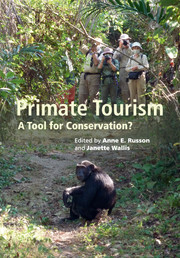Book contents
- Frontmatter
- Contents
- List of contributors
- Part I Introduction
- Part II Asian primates
- Part III African primates
- 7 Lemurs and tourism in Ranomafana National Park, Madagascar
- 8 Some pathogenic consequences of tourism for nonhuman primates
- 9 Baboon ecotourism in the larger context
- 10 Mountain gorilla tourism as a conservation tool
- 11 Evaluating the effectiveness of chimpanzee tourism
- Part IV Neotropical primates
- Part V Broader issues
- Part VI Conclusion
- Index
- References
11 - Evaluating the effectiveness of chimpanzee tourism
from Part III - African primates
Published online by Cambridge University Press: 05 September 2014
- Frontmatter
- Contents
- List of contributors
- Part I Introduction
- Part II Asian primates
- Part III African primates
- 7 Lemurs and tourism in Ranomafana National Park, Madagascar
- 8 Some pathogenic consequences of tourism for nonhuman primates
- 9 Baboon ecotourism in the larger context
- 10 Mountain gorilla tourism as a conservation tool
- 11 Evaluating the effectiveness of chimpanzee tourism
- Part IV Neotropical primates
- Part V Broader issues
- Part VI Conclusion
- Index
- References
Summary
Introduction
Chimpanzee tourism confronts the same goals and concerns faced by all wildlife tourism initiatives. With the potential to generate funds critical to protecting habitat and help communities see value in the protection of native wildlife, wildlife tourism can greatly benefit endangered populations. However, designing and implementing tourism programs to benefit chimpanzee conservation specifically presents unique challenges. Unlike other species, chimpanzees’ nearly identical genetic similarity to humans puts them at an especially high risk of contracting human infectious diseases (Muehlenbein et al., 2010; Woodford et al., 2002), making careful evaluation of the benefits and limitations of chimpanzee tourism programs critical.
In this chapter we will discuss chimpanzee tourism by examining its history and development, its benefits and limitations for chimpanzee conservation, various procedures and protocols, and the unique challenges faced at three sites: Gombe and Mahale Mountains National Parks in Tanzania and Kibale National Park in Uganda. We will evaluate the overall costs and benefits of chimpanzee tourism as they relate to chimpanzee conservation and weigh the risk factors such as disease, physiological stress, and increased human conflict against the benefits such as habitat protection and increased protection from hunting and poaching.
- Type
- Chapter
- Information
- Primate TourismA Tool for Conservation?, pp. 199 - 212Publisher: Cambridge University PressPrint publication year: 2014
References
- 4
- Cited by



